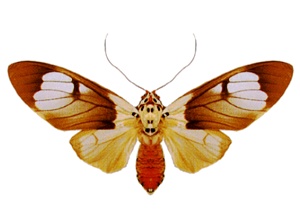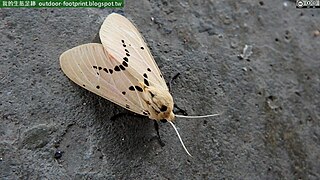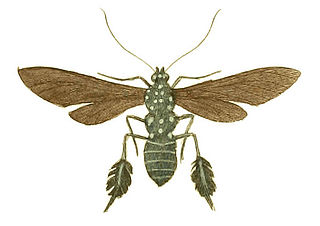
The Arctiinae are a large and diverse subfamily of moths with around 11,000 species found all over the world, including 6,000 neotropical species. This subfamily includes the groups commonly known as tiger moths, which usually have bright colours, footmen, which are usually much drabber, lichen moths, and wasp moths. Many species have "hairy" caterpillars that are popularly known as woolly bears or woolly worms. The scientific name Arctiinae refers to this hairiness. Some species within the Arctiinae have the word "tussock"' in their common names because they have been misidentified as members of the Lymantriinae subfamily based on the characteristics of the larvae.

Aethalida is a genus of tiger moths in the family Erebidae that occur in the Sundaland and Philippines.

Amerila is a genus of moths in the subfamily Arctiinae. A number of species in this genus have a special defence mechanism when they are in their adult stage. When disturbed, they exude a frothy yellow fluid from glands beside the eyes, while making a sizzling noise to ward off their attacker. Similar behaviour has been observed in fertilised females of the North-American moth Utetheisa ornatrix.

Are is a monotypic moth genus in the subfamily Arctiinae erected by Francis Walker in 1855. The type species is Are druryi, which is found on Jamaica. This species was described by Dru Drury in 1773 under the name Phalaena marginata, but this name is preoccupied by Phalaena marginataLinnaeus, 1758 and a new specific epithet, honouring Drury, was assigned in 1986.
Eyralpenus is a genus of tiger moths in the family Erebidae. The genus was erected by Arthur Gardiner Butler in 1875. The moths in the genus are found in the Afrotropics.

Spilarctia is a genus of moths in the family Erebidae. The genus was erected by Arthur Gardiner Butler in 1875.

Argina astrea, the crotalaria podborer, is a moth of the family Erebidae. The species was first described by Dru Drury in 1773. It is found in eastern Africa, southern Asia of India, Sri Lanka, and Indo-Australia, including the Pacific Islands and Australia.

Spilosoma alberti is a moth of the family Erebidae. It was described by Walter Rothschild in 1914. It is found on Papua New Guinea, where it is restricted to mountainous areas at high altitudes ranging from 1,200 to 2,150 meters.
Micraloa emittens is a moth of the family Erebidae. It was described by Francis Walker in 1855. It is found in India and Sri Lanka.
Amerila abdominalis is a moth of the subfamily Arctiinae. It was described by Walter Rothschild in 1933. It is found in Indonesia and Malaysia.
Amerila curta is a moth of the subfamily Arctiinae. It was described by Walter Rothschild in 1917. It is found on the Umboi Islands of Papua New Guinea.
Amerila erythropus is a moth of the subfamily Arctiinae. It was described by Walter Rothschild in 1917. It is found on the Umboi Islands of Papua New Guinea.
Amerila eugenia is a moth of the subfamily Arctiinae. It was described by Johan Christian Fabricius in 1794. It is found in China, Pakistan (Karachi), central and southern India and Sri-Lanka.
Amerila fumida is a moth of the subfamily Arctiinae. It was described by Charles Swinhoe in 1901. It is found in Indonesia.
Amerila kuehni is a moth of the subfamily Arctiinae. It was described by Walter Rothschild in 1910. It is found on Damar Island in Indonesia.
Amerila lactea is a moth of the subfamily Arctiinae. It was described by Walter Rothschild in 1910. It is found in Myanmar and Nepal.
Amerila rhodopa is a moth of the subfamily Arctiinae. It was described by Francis Walker in 1865. It is found in India.
Amerila rufitarsis is a moth of the subfamily Arctiinae. It was described by Walter Rothschild in 1917. It is found in Papua New Guinea and New Britain.

Horama plumipes is a moth of the subfamily Arctiinae. It was described by Dru Drury in 1773. It is found in southern Texas, Mexico, Honduras, Belize, Guatemala and Nicaragua.

Trichura coarctata is a moth in the subfamily Arctiinae. It was described by Dru Drury in 1773. It is found in Brazil.









